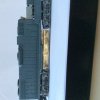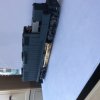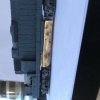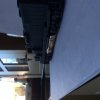jonte
Western Thunderer
Welcome to Robust, Ohio, a down-at-heel Class III shortline on the former Toledo, Wabash & Western Railroad. Once a vital exchange yard of some importance, but no longer supplemented by its primary customer - a long since departed sand/ gravel industry - it now serves as mere storage sidings for its current operator, the fictional Fulcrum County Railroad.
To give you an idea of the decrepitude I seek, may I present you with the influences for this project
The Maumee and Western Railroad at Defiance https://www.flickr.com/groups/2120328@N24/
Also https://www.flickr.com/groups/2120328@N24/
Athens shortline, Georgia
Fulton County Railroad
Now, I should point out that this isn't really a layout at all but a simple 'dio' on which to practise scenic techniques such as ballasting - never done it before - and ground cover - again, never got this far before - prior to doing it for real on my current project Industrial Place, LA. In the process, I hope to rekindle my interest in modelling and get my mojo back.
As with the main layout, time is of a premium at the moment, however, I found a little time this week to make a start on the baseboards. Attached are a couple of hastily taken shots to whet your appetite.
In an attempt to keep costs to a minimum, I've just reused bits and pieces lying around, so, I suppose it's also an exercise in recycling. For instance, at the end of last summer, my neighbour donated several lengths of poor quality exterior 6 milli ply which had spent several months open to the elements, acting as makeshift ramps for his children: "you're always doing things with wood!". Hmm...I was just too polite to say no, so feigning gratitude, I gleefully stored them in the garage to await an opportunity to take them to the tip. Anyway, rummaging around for suitable materials the other day, my attention was once more drawn to the now dried out muddy timber, and to my surprise, apart from one piece, the warping wasn't too bad and thinking that a suitable brace of two by one would remove the odd 'wave', I set about attacking it with my trustee hand saw and electric jig saw. And hey presto, a couple of days later three curvy boards - in plan not elevation - had limped off the production line. Even the 'warped beyond belief' piece was pressed into service, forming the skirted edge of each.
And so to the plan. Well, it's simply a 5-3-3 Inglenook, consisting of two handbuilt switches that had sat gathering dust on my desk for Lord knows how long - in fact, one of them wasn't even finished requiring wing and switch rails to complete it - to form two of the sidings, with the 'main' acting as the third. To form the predetermined lengths of cars on the main, the three car length will be bounded by a catch point to one side, with a simple country road crossing bounding the loco and three to the other, the idea being that a bye law prevents the loco fouling the crossing while switching. I trust this will provide a unique take on the oft replicated subject. I sincerely hope you'll agree. As they say, a picture paints a thousand words so I'll provide a sketch of the track plan over the next couple of days.
That's about it for now, but I'll try and update the thread as and when I (slowly) make some progress. I hope you find it of interest.
Jonte
To give you an idea of the decrepitude I seek, may I present you with the influences for this project
The Maumee and Western Railroad at Defiance https://www.flickr.com/groups/2120328@N24/
Also https://www.flickr.com/groups/2120328@N24/
Athens shortline, Georgia
Fulton County Railroad
Now, I should point out that this isn't really a layout at all but a simple 'dio' on which to practise scenic techniques such as ballasting - never done it before - and ground cover - again, never got this far before - prior to doing it for real on my current project Industrial Place, LA. In the process, I hope to rekindle my interest in modelling and get my mojo back.
As with the main layout, time is of a premium at the moment, however, I found a little time this week to make a start on the baseboards. Attached are a couple of hastily taken shots to whet your appetite.
In an attempt to keep costs to a minimum, I've just reused bits and pieces lying around, so, I suppose it's also an exercise in recycling. For instance, at the end of last summer, my neighbour donated several lengths of poor quality exterior 6 milli ply which had spent several months open to the elements, acting as makeshift ramps for his children: "you're always doing things with wood!". Hmm...I was just too polite to say no, so feigning gratitude, I gleefully stored them in the garage to await an opportunity to take them to the tip. Anyway, rummaging around for suitable materials the other day, my attention was once more drawn to the now dried out muddy timber, and to my surprise, apart from one piece, the warping wasn't too bad and thinking that a suitable brace of two by one would remove the odd 'wave', I set about attacking it with my trustee hand saw and electric jig saw. And hey presto, a couple of days later three curvy boards - in plan not elevation - had limped off the production line. Even the 'warped beyond belief' piece was pressed into service, forming the skirted edge of each.
And so to the plan. Well, it's simply a 5-3-3 Inglenook, consisting of two handbuilt switches that had sat gathering dust on my desk for Lord knows how long - in fact, one of them wasn't even finished requiring wing and switch rails to complete it - to form two of the sidings, with the 'main' acting as the third. To form the predetermined lengths of cars on the main, the three car length will be bounded by a catch point to one side, with a simple country road crossing bounding the loco and three to the other, the idea being that a bye law prevents the loco fouling the crossing while switching. I trust this will provide a unique take on the oft replicated subject. I sincerely hope you'll agree. As they say, a picture paints a thousand words so I'll provide a sketch of the track plan over the next couple of days.
That's about it for now, but I'll try and update the thread as and when I (slowly) make some progress. I hope you find it of interest.
Jonte
Attachments
-
 image.jpg189.9 KB · Views: 80
image.jpg189.9 KB · Views: 80 -
 image.jpg211.6 KB · Views: 79
image.jpg211.6 KB · Views: 79 -
 image.jpg174.3 KB · Views: 79
image.jpg174.3 KB · Views: 79 -
 image.jpg192.1 KB · Views: 80
image.jpg192.1 KB · Views: 80 -
 image.jpg140.7 KB · Views: 79
image.jpg140.7 KB · Views: 79 -
 image.jpg234.4 KB · Views: 81
image.jpg234.4 KB · Views: 81 -
 image.jpg179.4 KB · Views: 78
image.jpg179.4 KB · Views: 78 -
 image.jpg224.2 KB · Views: 78
image.jpg224.2 KB · Views: 78 -
 image.jpg164.9 KB · Views: 80
image.jpg164.9 KB · Views: 80 -
 image.jpg149.1 KB · Views: 78
image.jpg149.1 KB · Views: 78




















